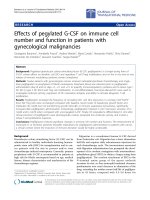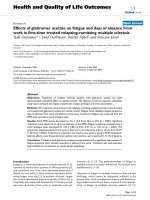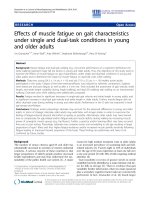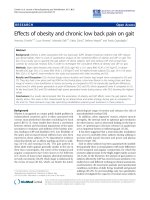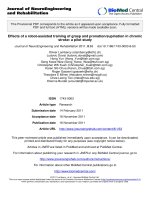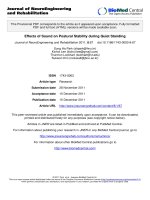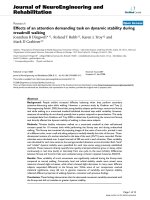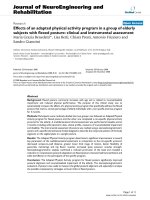báo cáo hóa học:" Effects of TGF-β1 and IGF-1 on proliferation of human nucleus pulposus cells in medium with different serum concentrations" pptx
Bạn đang xem bản rút gọn của tài liệu. Xem và tải ngay bản đầy đủ của tài liệu tại đây (2.04 MB, 11 trang )
BioMed Central
Page 1 of 11
(page number not for citation purposes)
Journal of Orthopaedic Surgery and
Research
Open Access
Research article
Effects of TGF-β1 and IGF-1 on proliferation of human nucleus
pulposus cells in medium with different serum concentrations
Rongfeng Zhang*, Dike Ruan
†
and Chao Zhang
†
Address: Department of Orthopaedic Surgery, Navy General Hospital of PLA, Beijing, 100037, People's Republic of China
Email: Rongfeng Zhang* - ; Dike Ruan - ; Chao Zhang -
* Corresponding author †Equal contributors
Abstract
Background: The low proliferative viability of human nucleus pulposus(NP) cells is considered as
a cause of intervertebral discs degeneration. Growth factors, such as TGF-β1 and IGF-1, have been
implicated in cell proliferation and matrix synthesis.
Objective: To investigate the dose-response and time-course effect of transforming growth
factorβ1(TGF-β1) and insulin-like growth factor-1(IGF-1) on proliferation of NP cells.
Study design: 3-(4,5-dimethylthiazolyl)-2,5-diphenyl-tetrazolium bromide (MTT) is reduced by
dehydrogenase in mitochondria of live cells. The proliferative viability of cells corresponds to the
amount of MTT reduced, which is measured with an enzyme-linked immunosorbent assay plate
reader. In this study, we assessed dose- and time-dependent effects of NP cells to TGF-β1 and IGF-
1 in medium with different serum concentrations by MTT assay.
Methods: After release of informed consent, tissue samples of NP were obtained from anterior
surgical procedures performed on five donors with idiopathic scoliosis. Isolated cells were cultured
in F12 medium supplemented with 10% fetal bovine serum(FBS). Cells were seeded in 96-well
plates at 1 × 10
3
cells/well. After synchronization, medium was replaced by F12 containing 1% or
10% FBS with either single or combination of TGF-β1 and IGF-1. Dose-response and time-course
effect were examined by MTT assay.
Results: In the presence of 1% FBS, the response to IGF-1 was less striking, whereas TGF-β1 had
a remarkably stimulating effect on cell proliferation. In 10% FBS, both of the two growth factors
had statistical significant mitogenic effects, especially TGF-β1. The dose-dependent effect of TGF
and IGF on cell proliferation was found within different concentrations of each growth factor(TGF-
β1 1–10 μg/L, IGF-1 10–100 μg/L). The time-course effect showed a significant elevation three days
later.
Conclusion: TGF-β1 and IGF-1 were efficient to stimulate cell proliferation of human NP cells in
vitro with a dose- and time-dependent manner. These results support the therapeutic potentials of
the two growth factors in the treatment of disc degeneration.
Published: 26 October 2006
Journal of Orthopaedic Surgery and Research 2006, 1:9 doi:10.1186/1749-799X-1-9
Received: 23 February 2006
Accepted: 26 October 2006
This article is available from: />© 2006 Zhang et al; licensee BioMed Central Ltd.
This is an Open Access article distributed under the terms of the Creative Commons Attribution License ( />),
which permits unrestricted use, distribution, and reproduction in any medium, provided the original work is properly cited.
Journal of Orthopaedic Surgery and Research 2006, 1:9 />Page 2 of 11
(page number not for citation purposes)
Background
Intervertebral disc(IVD) degeneration and associated spi-
nal disorders are a leading source of morbidity, resulting
in substantial pain and increased health care costs. The
exact mechanism of disc degeneration is not fully under-
stood. The NP tissue is avascular, gelatinous and lies in the
central of the IVD. Like the articular cartilage, NP receives
all nutrients by diffusion in bulk flow patterns[1]. As a
result, NP tissue is prone to degenerate. A central feature
of NP degeneration is loss of tissue cellularity. It has been
suggested that apoptosis may be an important event that
contributes to the death of cells in the disc[2].
Growth factors, such as TGF-β1 and IGF-1, have been
shown to stimulate chondrocytes and endotheliocytes
proliferation and matrix synthesis in vitro[3-5]. Many
researchers have studied the effects of growth factors on
NP cells, but a large number of them were confined to the
effect of single factor on cell phenotype, furthermore, the
exprimential objects were mainly rodent animals [6,7]. To
investigate the therapeutic potential in the treatment of
disc degeneration, we investigated the effects of TGF-β1
and IGF-1 on the proliferation of human NP cells in single
or combination by MTT colorimetric assay. The assay
detects the reduction of MTT by mitochondrial dehydro-
genase to blue formazan product, which reflects the nor-
mal functioning of mitochondria and hence cell
proliferation[8]. Different culture conditions were used to
assess the influence of changes in the external environ-
ment of the cells on their responsiveness to growth fac-
tors. Growth factors were added in increasing
concentrations to the culture medium to study their dose-
response and time-course effect on NP cells.
Materials and methods
Cell isolation and culture
Protocol for the experimental study was approved by our
institutional Research Review Committee. IVD specimens
were obtained from anterior surgical procedures per-
formed on five donors with idiopathic scoliosis(3 females
and 2 males; average age, 15.4 years; range, 11–19 years).
Specimens were transported in a sterile tube to the labora-
tory less than 30 min after surgical removed. The annulus
fibrosus and transition zone was removed with scalpel.
The NP tissue was careful separated from upper and lower
vertebral cartilage under a binocular microscope. After
rinsed twice in Ham's/F12(Hyclone) to remove residual
debris, NP tissue was minced with a scalpel into small
portions(1–2 mm2) and digested for 30 minutes at 37°C
in 0.25% trypase(Gibco), followed by 4 hours in 0.2%
collagenase Type II (Gibco). The digest was filtered
through a 75-μm cell-strainer and cultured in T25
flasks(Costar) at a density of 1 × 104 cells/ml in F12 con-
taining 10% FBS(Hyclone) in a 37°C, 5%CO2 atmos-
phere. The medium was changed every 72 hours. When
cultures showed a 80% confluency, cells were trypsinized
and a split ratio of 1:4 was used for subculturing. Cell via-
bility, determined by trypan blue(Hyclone) exclusion,
averaged 96% on monolayer culture. Cellular morphol-
ogy cultured in 96-well plates was observed microscopi-
cally every day so as to observe the effects of growth
factors on cells.
Effects of TGF-
β
1 and IGF-I on cell proliferation
After reaching 80% confluency, the cells(passage = 2)
were trypsinized and cultured in 96-well plates at a den-
sity of 1 × 10
4
/ml in F12 containing 10% FBS with 0.1 ml
per well. After 24 hours of adherence, the medium was
changed by F12 without FBS and the cells were cultured
for another 12 hours to ensure the cells synchronization.
1. Dose-response effect of growth factors on cell proliferation
A 96-well plate with synchronal NP cells was taken and
the medium was removed, different concentrations of
growth factors dispensed by F12 with 1% or 10% FBS
were added to the plate. The TGF-β1 (Peprotech) and IGF-
1 (Peprotech) groups were all divided into eight concen-
tration groups: 0.1, 0.5, 1.0, 5.0, 10, 50, 100, 500 μg/L.
F12 contained 1% or 10% FBS without growth factors was
used as control groups. Every specimen was prepared in
four replicates. After incubating cells for 72 hours, 20 μL
of 5 mg/mL MTT (Sigma)in phosphate buffered saline
was added to each well and the plate was incubated at
37°C for 4 hours. The medium was removed and 100 μl
of dimethyl sulfoxide(DMSO, Sigma) per dish was then
added. After agitation at 25°C for 10 minutes, optical
density in control and growth factor groups was assayed at
490 nm with an enzyme-linked immunosorbent assay
plate reader (bio-tek instruments).
2. Time-course effect of growth factors in single or combinations on
cell proliferation
Four 96-well plates with synchronal cells were used. The
medium was replaced by 10%FBS-F12 medium with
growth factors in optimal effect-concentration(acquired
by dose-effect experiment). This experiment was divided
into 4 groups: control group, 10 μg/L TGF-β1, 100 μg/L
IGF-1, 10 μg/L TGF-β1+ 100 μg/L IGF-1. Each condition
was repeated 4 times. The plates were incubated at 37°C.
Assay was carried out at 1-, 3 5- and 7-day using above
mentioned methods.
Statistical analyses
Standard statistical analytical methods were performed
using the SPSS11.0 system for windows. The effects of dif-
ferent groups were assessed with a one-way analysis of var-
iance(ANOVA) followed by a Fisher LSD post hoc test.
Signifcance was assumed when p < 0.05.
Journal of Orthopaedic Surgery and Research 2006, 1:9 />Page 3 of 11
(page number not for citation purposes)
Results
Dose-response effect of growth factors on cell
proliferation
Under 1% FBS condition, the optical density of the con-
trol group was 0.085 with a lower level of viability, as
shown in Fig. 1. Notably, there was no statistical signifi-
cance between the IGF-1 group and the control group. The
10 μg/L TGF-β1 group showed marked elevation in prolif-
eration compared to the control group (96.5%).
In the presence of 10% FBS, the optical density of the con-
trol group had an obvious elevation and reached 0.178,
about twice the optical density in the 1% FBS. The viabil-
ity of the cells had a further elevation as a result of expos-
ing to growth factors. As shown in Fig. 2, a significant
stimulating effect of TGF-β1 over doses of 1.0–500.0 μg/L
on NP cells, and the maximum stimulus with 10 μg/L of
the TGF-β1 reached a 72.4% increase compared with the
standard medium. The results also showed a mitogenic
effect of IGF-1 over doses of 10.0–500 μg/L after 72 hours
exposure. Cells showed the most marked elevation in pro-
liferation at the concentration of 100 μg/L IGF-1 com-
pared to controls(50.6%). Dose-dependent effects of TGF-
β1 and IGF-1 on cell proliferation were found between 1–
10 μg/L and 10–100 μg/L respectively. However, cell via-
bility showed a trend of decreasing in response to further
elevation of the concentrations.
Time-course effect of growth factors in single or
combinations
The optical density was assessed when NP cells were cul-
tured in medium supplemented with growth factors in
single or combinations in their optimal concentrations
(10 μg/L TGF-β, 100 μg/L IGF-1). Cell proliferation didn't
show significent increase at the first day of culture when
either growth factor was added to the medium(as shown
in Fig. 3). In the medium with 10% FBS, the responsive-
ness of NP cells to the growth factors showed a significant
increase compared to the control group after 3, 5, and 7
days of culture. Compared with the data of standard
medium at the 3 days, the proliferative percence of TGF-
β1, IGF-1 and TGF-β1+IGF-1 on cell proliferation was cal-
culated as 72.4% (P < 0.001), 50.6% (P < 0.01), and 86%
(P < 0.001) respectively. The total amount of cell prolifer-
ation by growth factors also had a marked elevation at 5
and 7 days. The clear time-dependent increase with
growth factors in the 10% FBS was observed. Stimulation
by TGF-β1+IGF-1 group was the maximum respectiveness
Dose-response effect of growth factors on proliferation of human NP cells (1%FBS/F12) (n = 20)Figure 1
Dose-response effect of growth factors on proliferation of human NP cells (1%FBS/F12) (n = 20). Cells were incu-
bated with increasing concentrations (0.1–500 μg/L) of TGF-β1 and IGF-I in 1%FBS/F12 medium for 72 hours. The proliferative
response was evaluated using MTT assay. Results were expressed as the mean optical density of MTT absorbance in growth
factors and control wells. ** P < 0.01, *** P < 0.001 versus control.
Journal of Orthopaedic Surgery and Research 2006, 1:9 />Page 4 of 11
(page number not for citation purposes)
at every time point among growth factors, which reached
71.3% (P = 0.001) and 59.3 (P < 0.01) increase at 5 and 7
days compared to the standard medium.
Effects of growth factors on cell morphology
When grown in monolayer culture and standard medium,
cells from normal human NP were spindle-shaped with
abundant cytoplasm and two pseudopods(Fig. 8). Under
1% FBS conditions, the control group NP cells lost their
normal morphology and trended to irregular, such as the
obviously enlongate pseudopods and decreased cyto-
plasm(Fig. 4). The morphology of cells exposure to IGF-1
showed no striking difference compared with the control
group(Fig. 6). However, cells in 1% FBS exposure to TGF-
β1 or TGF-β1+IGF-1 were similar to the normal NP cells
with regular spindle-shape (Fig. 5, 7).
The morphology of cells exposure to growth factors had
little change compared with the control group in the
medium containing 10% FBS in the early culture
stage(<72 hours). Whereas 72 hours later, the morphol-
ogy of growth factors groups trended to appear in short
spindle-shape or multiangular shape with pseudopods
shorter, cytoplasm aboundant and refractive power
stronger compared to the control group(Fig. 9, 10). Cells
of exposure to TGF-β1(10 μg/L) + IGF(100 μg/L) showed
a maximum changes in morphology(Fig. 11). No big dif-
ference was noted in cell morphology between TGF-β1
and IGF-1 groups.
Discussion
In the present study, we observed profound changes in
cell morphology and proliferation in samples cultured
within medium containing TGF-β1. This is well supported
also by previous studies in the literature. Joon et al[9] cul-
tured human IVD cells in monolayer, alginate beads, or
pellets, found proteoglycan synthesis increased 150–
180%, 250–315%, or 375–425% over their controls
respectively at 3 weeks. The pellets also increased synthe-
sis of collagen Type II in response to TGF-β1. More
recently, Tan et al[10] found a significant increase of the
proteoglycan and collagen synthesis after infection of Ad/
CMV-hTGF encoding gene into the degenerated disc cells,
the structure and function of the degenerated cells
changed remarkably. Alini et al[11] observed an increase
and maintain in density of bovine NP cells and synthesis
Dose-response effect of growth factors on proliferation of human NP cells (10%FBS/F12) (n = 20)Figure 2
Dose-response effect of growth factors on proliferation of human NP cells (10%FBS/F12) (n = 20). Cells were
incubated with increasing concentrations (0.1–500 μg/L) of TGF-β1 and IGF-I in 10%FBS/F12 medium for 72 hours. The prolif-
erative response was evaluated by MTT assay. Results were expressed as the mean optical density of MTT absorbance in
growth factors and control wells. * P < 0.05, ** P < 0.01, *** P < 0.001 versus control.
Journal of Orthopaedic Surgery and Research 2006, 1:9 />Page 5 of 11
(page number not for citation purposes)
of proteoglycan. Gu[12] reported a stimulatory effect in
proteoglycan core protein gene expression of TGF-β1 on
the high-passage dedifferential NP cells. In addition, the
dose-dependent effect of TGF-β1 on cell proliferation was
found between the concentration ranges of 1.0–10 μg/L,
This range is very important in the future therapeutic
applications of the TGF-β1 in human disc degeneration,
and has not been reported previously.
It has long been appreciated that NP tissue is a low nutri-
tion region. In this in vitro study, when NP cells was cul-
tured in medium with 1% FBS(necessary for basal cell
maintenance, the cells showed a morphologic characteris-
tics of nutrition deficiency. However, adding TGF(10 μg/
L) in the medium resulted in a total recovery of cell mor-
phology to that of normal cells cultured in standard
medium and a 96.5% increase of cell proliferation over
the control group. The results suggested that TGF-β1 play
an important role in mitogensis at low nutrient condi-
tions.
IGF-1 has been reported to stimulate cell proliferation and
matrix synthesis, maintain cell phenotype in vitro[13].
Osada et al[14] demonstrated the generation and expres-
sion of IGF-1 mRNA in the bovine NP cells. The study
showed an autocrine/paracrine mechanism of IGF-1
secretion, and the stimulative effect of IGF-1 on proteogly-
can synthesis in bovine IVD. More recently, Gruber[15]
demonstrated a significant reduction in the percentage of
apoptotic disc cells after exposure to 50–500 ng/ml IGF-1
and suggested that IGF-1 could retard or prevent pro-
grammed cell death in vitro. The results presented in this
report showed the response to IGF-1 was less striking in
1%FBS, but a marked elevation in cell proliferation and
the dose-dependent effect was found between the concen-
trations of 10–100 μg/L IGF-1 in the presence of 10% FBS.
Time-course effect of growth factors on proliferation of human NP cells (10%FBS/F12) (n = 20)Figure 3
Time-course effect of growth factors on proliferation of human NP cells (10%FBS/F12) (n = 20). The proliferative
response was evaluated by MTT assay at 1-, 3 5- and 7-day. Results were expressed as the mean optical density of MTT
absorbance in growth factors in single or combinations and control wells. * P < 0.05, ** P < 0.01, *** P < 0.001 versus control.
Journal of Orthopaedic Surgery and Research 2006, 1:9 />Page 6 of 11
(page number not for citation purposes)
The morphology of human NP cells under 1%FBS conditionsFigure 4
The morphology of human NP cells under 1%FBS conditions. 1%FBS, NP cells lost their normal morphology and
trended to irregular.(×100).
The morphology of human NP cells under 1%FBS conditionsFigure 5
The morphology of human NP cells under 1%FBS conditions. 1%FBS, 10 μg/L TGF-β1, NP cells were similar to the
normal NP cells with regular spindle-shape. (×100).
Journal of Orthopaedic Surgery and Research 2006, 1:9 />Page 7 of 11
(page number not for citation purposes)
The morphology of human NP cells under 1%FBS conditionsFigure 6
The morphology of human NP cells under 1%FBS conditions. 1%FBS, 100 μg/L IGF-1, NP cells showed an irregular
morphology with low mitotic activity. (×100).
The morphology of human NP cells under 1%FBS conditionsFigure 7
The morphology of human NP cells under 1%FBS conditions. 1%FBS, 10 μg/L TGF-β1+100 μg/L IGF-1, NP cells
trended to appear in short spindle-shape with short pseudopods. (×100).
Journal of Orthopaedic Surgery and Research 2006, 1:9 />Page 8 of 11
(page number not for citation purposes)
The morphology of human NP cells under 10%FBS conditionsFigure 8
The morphology of human NP cells under 10%FBS conditions. 10%FBS, NP cells were spindle-shaped with abundant
cytoplasm and two pseudopods. (×100).
The morphology of human NP cells under 10%FBS conditionsFigure 9
The morphology of human NP cells under 10%FBS conditions. 10%FBS, 10 μg/L TGF-β1, NP cells trended to appear
in short spindle-shape or multiangular shape with short pseudopods and aboundant cytoplasm compared to the control group.
(×100).
Journal of Orthopaedic Surgery and Research 2006, 1:9 />Page 9 of 11
(page number not for citation purposes)
The morphology of human NP cells under 10%FBS conditionsFigure 10
The morphology of human NP cells under 10%FBS conditions. 10%FBS, 100 μg/L IGF-1, the morphology of NP cells
were similar to the 10 μg/L TGF-β1 group. (×100).
The morphology of human NP cells under 10%FBS conditionsFigure 11
The morphology of human NP cells under 10%FBS conditions. 10%FBS, 10 μg/L TGF-β1+100 μg/L IGF-1, NP cells
showed a maximum changes in morphology with short pseudopods and aboundant cytoplasm. (×200).
Journal of Orthopaedic Surgery and Research 2006, 1:9 />Page 10 of 11
(page number not for citation purposes)
However, cell viability decreased with further raise of the
concentration. This probably related to the bound state of
cell surface receptors. No significant effect in 1% FBS
revealed that the proliferative effect of IGF-1 perhaps rely
on other components in the serum.
Irrespective of which growth factor was added, no signifi-
cant stimulation of this proliferation rate was observed at
the first day of our experiments. This may be a delayed
response of growth factors on cell proliferation. The exact
mechanism is not fully understood at present.
The final goal of the present study is to provide the basis
for the development of an efficient application of growth
factors in the treatment of IVD degeneration. Firstly, the
use of growth factors by intradiscal application in vivo
might help the disc increase cell proliferation and stimu-
late matrix production, especially for individuals in the
early stage of degeneration found by MRI examina-
tion[16]. An[17] reported that the intradiscal administra-
tion of osteogenic protein-1 by injection in vivo resulted
in an increased disc height present at 2, 4, and 8 weeks
and an increase in proteoglycan content of the rabbit
nucleus pulposus at the 2-week time point. This demon-
strated the potential in vivo effects of growth factors on
the IVD degeneration by direct injection approach. Sec-
ondly, tissue-engineering and gene therapy techniques
could offer a sustained release of growth factors, and the
results from the present study could be used in the regen-
eration of the lost functional capacity of the degenerative
IVD. However, seed cells continue to be the problems,
such as limited source, minor amounts and lower viabil-
ity. According to this study, TGF-β1 and IGF-1 are effective
factors to stimulate proliferation of the seed cells.
In summary, the results demonstrate the effectiveness of
TGF-β1 and IGF-1 in stimulating cell proliferation and
maintaining morphology of human NP cells. There exist
an optimal range for cell stimulation, and a synergic effect
was observed when two growth factors were applied at the
same time. These results provide useful information for
possible clinical application in future. However, further
studies such as the effects of growth factors on degenera-
tive disc tissue in vivo, and the delivery carrier of the
growth factors should be performed in small and large
animals.
Abbreviations
MTT = methyl thiazolyl tetrazolium; TGF-β1 = transform-
ing growth factorβ1; IGF-1 = insulin-like growth factor-1;
NP = nucleus pulposus; FBS = fetal bovine serum; IVD =
Intervertebral disc.
Competing interests
national natural science funds were received in support of
this work. No benefits in any form have been or will be
received from a commercial party related directly or indi-
rectly to the subject of this report.
Authors' contributions
R.F. Zhang carried out the cell culture and MTT assay, par-
ticipated in the acquisition of data and drafted the manu-
script. Z. Chao participated in the design of the study and
performed the statistical analysis. D.K. Ruan conceived of
the study, participated in its design and revised the manu-
script. All authors read and approved the final manu-
script.
Acknowledgements
The authors thank Xiaohang Zhao and Lijun Zhou from the central laborary
of navy general hospital for their expert technical assistance.
References
1. Le Maitre , Hoyland , Freemont , et al.: Studies of human interver-
tebral disc cell function in a constrained in vitro tissue cul-
ture system. Spine 2004, 29:1187-1195.
2. Horner HA, Roberts S, Bielby RC, et al.: Cells from different
regions of the intervertebral disc:effect of culture system on
matrix expression and cell phenotype. Spine 2002, 27:1018-28.
3. Delatte , Von , Nottet , et al.: Growth regulation of the rat man-
dibular condyle and femoral head by transforming growth
factor-beta1, fibroblast growth factor-2 and insulin-like
growth factor-I. European Journal of Orthodontics 2005, 27(1):17-26.
4. Chaipinyo K, Oakes BW, Van MP: Effects of growth factors on
cell proliferation and matrix synthesis of low-density, pri-
mary bovine chondrocytes cultured in collagen I gels. J Ortho
Res 2002, 20(5):1070-8.
5. Wu WC, Kao YH, Chung CH: Effects of growth-factor combina-
tions on vascular endothelial cell growth in vitro. J Ocul Phar-
macol Ther 2004, 20(6):554-62.
6. Sobajima S, Shimer AL, Chadderdon RC, et al.: Quantitative analy-
sis of gene expression in a rabbit model of intervertebral disc
degeneration by real-time polymerase chain reaction. Spine
J 2005, 5(1):14-23.
7. Pattison ST, Melrose J, Ghosh P, et al.: Regulation of gelatinase-A
(MMP-2) production by ovine intervertebral disc nucleus
pulposus cells grown in alginate bead culture by Transform-
ing Growth Factor-beta(1) and insulin like growth factor-I.
Cell Biol Int 2001, 25(7):679-89.
8. Loveland BE, Johns TG, Mackay IR, Vaillant F, Wang ZX, Hertzog PJ:
Validation of the MTT dye assay for enumeration of cells in
proliferative and antiproliferative assays. Biochem Int 1992,
27:501-510.
9. Joon YL, Ronald H, Dalip P, et al.: New use of a three-dimensional
pellet culture system for human intervertebral disc cells.
Spine 2001,
26:2316-2322.
10. Tan YB, Hu YG, Tan YW: Extracellular matrix synthesis and
ultrastructural changes of degenerative disc cells transfected
by Ad/CMV-hTGF-beta 1. Chin-Med-J-(Engl) 2003,
116(9):1399-1403.
11. Alini M, Wei L, Markovic P, et al.: The potential and limitations
of a cell-seeded collagen/hyaluronan scaffold to engineer an
intervertebral disc-like matrix. Spine 2003, 28:446-454.
12. Shouming Gu, Yougu Hu: The regulatory effects of transforming
growth factorβ on the proteoglycan core protein gene
expression in high-passage nucleus pulposus cells. Journal of
Chinese Medicine 1999, 79(12):917-918.
13. Hiraki Y, Inoue H, Kato Y, et al.: Combined effects of somatome-
din-like growth factors with fibroblast growth factor or epi-
dermal growth factor in DNA synthesis in rabbit
chondrocytes. Mol Cell Bio Chem 1987, 76:185-193.
Publish with BioMed Central and every
scientist can read your work free of charge
"BioMed Central will be the most significant development for
disseminating the results of biomedical research in our lifetime."
Sir Paul Nurse, Cancer Research UK
Your research papers will be:
available free of charge to the entire biomedical community
peer reviewed and published immediately upon acceptance
cited in PubMed and archived on PubMed Central
yours — you keep the copyright
Submit your manuscript here:
/>BioMedcentral
Journal of Orthopaedic Surgery and Research 2006, 1:9 />Page 11 of 11
(page number not for citation purposes)
14. Osada R, Ohshima H, Ishihara H, et al.: Autocrine/paracrine
mechanism of insulin-like growth factor-1 secretion, and the
effect of insulin-like growth factor-1 on proteoglycan synthe-
sis in bovine intervertebral discs. J-Orthop-Res 1996,
14(5):690-699.
15. Gruber HE, Norton HJ, Hanley EN: Anti-apoptotic effects of IGF-
1 and PDGF on human intervertebral disc cells in vitro. Spine
2000, 25(17):2153-2157.
16. Takegami K, An H, Kumano F, et al.: Osteogenic protein-1 is most
effective in stimulating nucleus pulposus and anulus fifbrosus
cells to repair their matrix after chondroitinase ABC-
induced in vitro chemonucleolysis. The spine journal 2005,
5:231-238.
17. An H, Takegami K, Kamada H, et al.: Intradiscal administration of
osteogenic protein-1 increases intervertebral disc height and
proteoglycan content in the nucleus pulposus in normal ado-
lescent rabbits. Spine 2005, 30:25-32.
